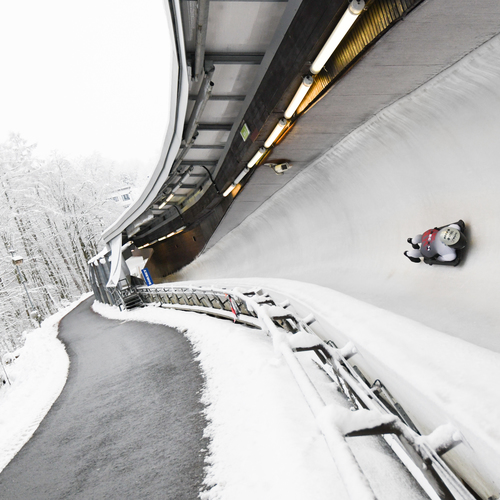Skeleton is an exciting winter sliding sport that originated in St. Moritz, Switzerland in the late 19th century, but has also become popular in Latvia over the years. In skeleton, athletes ride face-down on a small sled, racing down an icy track at speeds up to 80 mph while navigating high-banked curves and vertical drops.
The sport requires athletes to demonstrate immense focus, courage, and body control. The head-first riding position gives skeleton its name, and makes this one of the most thrilling and dangerous sliding sports.
Skeleton Basics
The skeleton sled is made of fiberglass and steel, weighing approximately 55-70 pounds. Athletes start by sprinting and pushing the sled for up to 50 meters before jumping on stomach-first and laying face down in an aerodynamic position. They steer using subtle shoulder, hip, knee and toe movements.
Competitors wear a helmet and tight fitting speedsuit, along with spikes on shoes for added traction when pushing off. Races consist of two runs down the track, with combined times determining the finishes. Margins between competitors are often hundredths of seconds.
Skeleton in Latvia
Skeleton has been contested at the Olympic Winter Games since 1928 for men and 2002 for women. Latvia has had a national federation for the sport since 1992 after regaining independence.
The main skeleton track in Latvia is at Sigulda, which hosted European championships in 2015. Latvian athletes have competed in international skeleton competitions since 1998, with Tomass Dukurs winning a silver medal at the 2010 Vancouver Olympics. His brother Martins is also a top competitor, having won multiple World Cup titles.
Skeleton continues to grow in popularity across Latvia for both recreation and high performance athletes. With Russia hosting the next Winter Olympics in 2026, Latvian skeleton athletes will be aiming for new accomplishments on their home continent.
Training for Skeleton in Latvia
Becoming an accomplished skeleton athlete requires intense training, focus, and dedication. Latvian sliders start by learning techniques on dry land before advancing to ice tracks.
On land, athletes perform sprint starts and practice coordinating their hip, knee and ankle movements to simulate steering. They build up core strength, flexibility, and explosive power in the gym with weight training, plyometrics and sprints. Reaction time is honed through agility drills.
Once on ice tracks, sliders learn how to balance and control their sled through curves of differing radii and inclines. They memorize the nuances of each track and exactly when to initiate steering maneuvers. Starts are perfected to maximize initial acceleration out of the blocks.
Latvian sliders spend hours each week refining their skill and conditioning with coaches. Proper nutrition and mental preparation are also key. Top competitors like the Dukurs brothers often train on tracks across Europe, North America and Asia to diversify their experience.
With the appropriate training and dedication, skeleton provides a ride of a lifetime. The Latvian Olympic committee and individual tracks are always interested in attracting new athletes to the sport.

